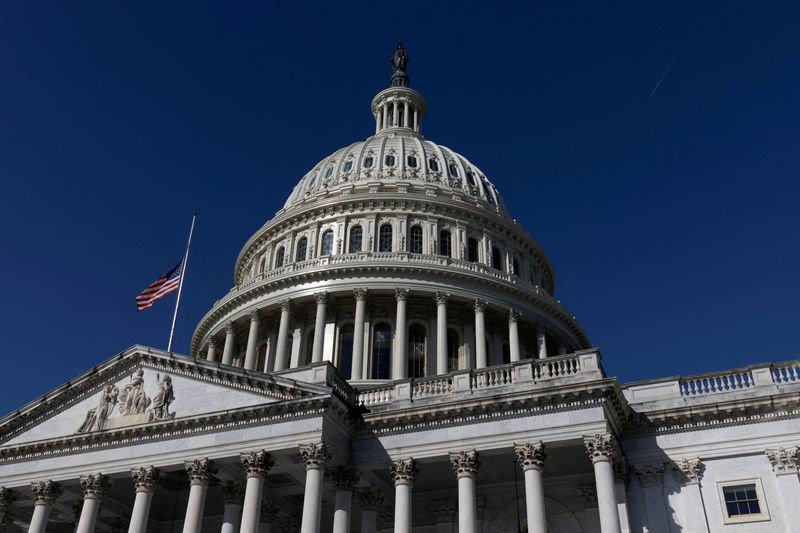
© Reuters. FILE PHOTO: General view of the U.S. Capitol during morning hours, in Washington, U.S., March 30, 2023. REUTERS/Tom Brenner/File Photo
By David Morgan and Richard Cowan
WASHINGTON (Reuters) – The Republican-controlled U.S. House of Representatives and the Democratic-led Senate this week will start to seek the upper hand in a spending showdown that could trigger a government shutdown just months after Congress narrowly avoided default.
Hardline Republicans are pushing their leader, House Speaker Kevin McCarthy, to cut budgets below the levels he and Democratic President Joe Biden agreed to a little more than a month ago. But Senate appropriators are aiming for bipartisan deals — all of which point to difficult negotiations ahead — as Congress returns from a two-week July 4 recess.
A host of hot-button issues ranging from abortion to transgender rights are expected to be pulled into the debates, further complicating matters. If lawmakers fail to agree on a budget before the next fiscal year begins on Oct. 1, the United States could see its fourth partial government shutdown in a decade.
“July is going to have a lot of late-night votes and a lot of really big issues being tackled,” House Majority Leader Steve Scalise, the chamber’s No. 2 Republican, said in an interview. “Start the appropriations process, get the Senate moving appropriations bills. I think that alone would be a victory.”
House Republicans are aiming to craft a series of 12 detailed spending bills covering every aspect of government funding, an intricate feat Congress has not pulled off on time since fiscal 1997. Last year, all 12 — totaling $1.7 trillion — were crammed into one sweeping “omnibus” bill.
Senate negotiators, who were largely sidelined during the recent talks between House Republicans and the White House over the federal government’s $31.4 trillion debt ceiling, were working on bills that are attracting strong bipartisan support.
“We are determined to continue working together in a bipartisan manner to craft serious funding bills that can be signed into law,” Democratic Senator Patty Murray and Republican Senator Susan Collins said in a joint statement.
Republicans hold the House by a narrow 222-212 majority, while Democrats hold a razor-thin 51-49 majority in the Senate, meaning that nothing can pass into law without votes from both parties.
CONFLICTING TARGETS
Leaders of the two chambers don’t even agree on the spending targets they are aiming at.
Senate negotiators plan to hold to the $1.59 trillion discretionary spending target that Biden and McCarthy agreed to in the May deal that averted default. House Republicans last month voted on a lower target of $1.47 trillion, which would cut spending for the environment, public assistance and foreign aid.
“House Republicans really are committed to shrinking spending. Not everyone in the Senate agrees with that approach,” said Representative Dusty Johnson, who chairs the Main Street Caucus, which includes more than 70 Republicans. “That has been the source of a little bit of tension to date, and I think that has the potential to grow.”
Spending is only one flashpoint. House Republicans are also trying to use the legislation to rescind key Biden priorities in areas such as climate change and tax collection. They also seek to eliminate or alter some existing programs involving workforce diversity, transgender protections and women’s access to abortion that Democrats are fighting for.
“I am ready to end this charade of considering extreme Republican funding bills and join my colleagues in both chambers and on both sides of the aisle in working toward a final agreement” on government spending for next year, Democratic Representative Rosa DeLauro said in a statement to Reuters on Friday.
She is the senior Democrat on the House Appropriations Committee, and noted that, given the House Republicans’ slim majority, “They know and have said publicly, that in the end they are going to need Democratic votes to keep the government open.”
Failure to agree on appropriations could lead to a partial government shutdown into the autumn and winter that could hobble many federal activities, including air traffic control, military pay increases and the operation of national parks.
Some of the roughly three dozen members of the hardline Republican House Freedom Caucus have suggested in the past that a shutdown would not be an unwelcome outcome.
But Representative David Joyce, who chairs the Republican Governance Group, or RG2, a more moderate group of 42 lawmakers concerned with House governance, said there could be scope for a short-term funding deal to maintain government operations while talks continue into the fall.
“I’m not a big fan at all of shutdowns, and I don’t think anybody in RG2 or our groups are really thinking about that,” Joyce told Reuters. “We’re trying to think how to make things work.”





